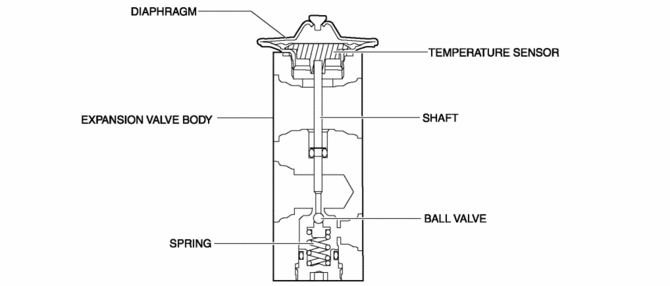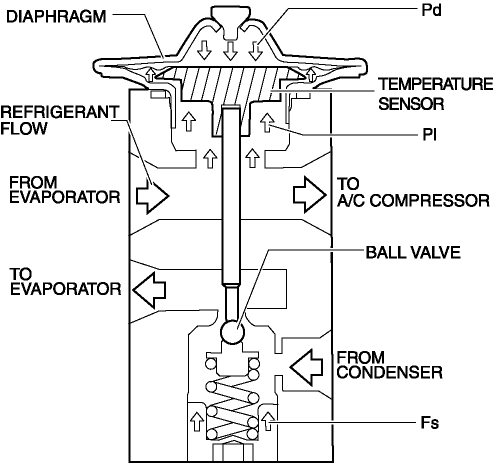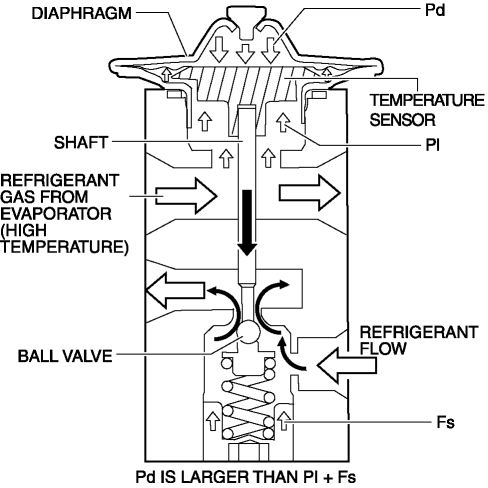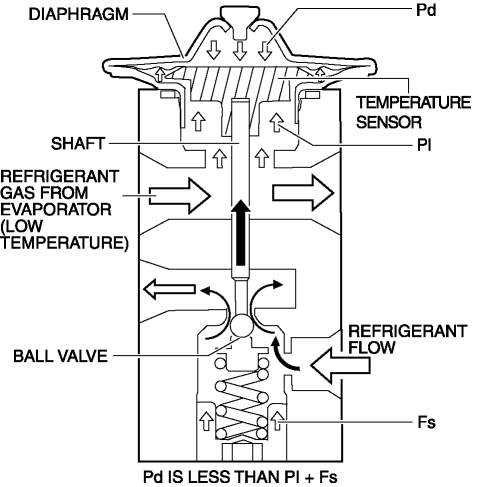Mazda CX-5 Service & Repair Manual: Expansion Valve
Purpose
-
The expansion valve atomizes liquid refrigerant to facilitate cooling of the evaporator.
Function
-
The expansion valve reduces the pressure of liquid refrigerant rapidly to facilitate vaporization of the atomized refrigerant at the evaporator, and adjusts the refrigerant amount sent into the evaporator.
Construction
-
The expansion valve consists of the following parts:
-
Diaphragm
-
Temperature sensor
-
Shaft
-
Expansion valve body
-
Ball valve
-
Spring

Operation
-
Adjustment of the refrigerant amount supplied to the evaporator is performed by the ball valve opening angle in the expansion valve.
-
The opening angle adjustment is performed according to the balance of the following forces:

-
Refrigerant pressure (Pd) in diaphragm
-
Refrigerant gas pressure (PI) of evaporator under diaphragm
-
Spring force (Fs) pushing up ball valve
-
If the refrigerant gas temperature from the evaporator increases, the expansion valve increases the amount of refrigerant according to the following operations:

-
The temperature of the temperature sensor tightly sealed against the diaphragm increases.
-
The refrigerant in the diaphragm warms and the Pd increases.
-
If this Pd increases more than PI + Fs, the diaphragm is pressed down.
-
The shaft installed to the temperature sensor end presses down the ball valve.
-
The amount of refrigerant is increased.
-
If the refrigerant gas temperature from the evaporator decreases, the expansion valve decreases the amount of refrigerant flow according to the following operation:

-
The temperature of the temperature sensor tightly sealed against the diaphragm decreases.
-
The refrigerant temperature in the diaphragm decreases and the Pd decreases.
-
The Pd decreases less than PI + Fs.
-
The ball valve installed to the temperature sensor end is pressed up.
-
The amount of refrigerant is decreased.
Fail-safe
-
Function not equipped.
 Evaporator Inspection
Evaporator Inspection
1. Inspect the evaporator for damage, cracks, and oil leakage.
If there is any malfunction, replace the evaporator.
2. Visually inspect the fins for bending.
If there is any bend ...
 Expansion Valve Removal/Installation
Expansion Valve Removal/Installation
1. Disconnect the negative battery cable..
2. Discharge the refrigerant from the system..
CAUTION:
If moisture or foreign material enters the refrigeration cycle, cooling ability
will b ...
Other materials:
Door Lock Switch Removal/Installation
Driver's Side
NOTE:
The driver's side door lock switch cannot be removed as a single unit because
it is built into the power window main switch. If the driver's side door lock
switch is replaced, replace the power window main switch..
Passenger's Side
1. Disconn ...
On/Off Solenoid [Fw6 A EL, Fw6 Ax EL]
Purpose/Function
The on/off solenoid performs switching of the shift valve in the control
valve body according to the vehicle conditions.
Construction
The on/off solenoid is installed to the solenoid control valve body.
The on/off solenoid is a normal open-type on/off ...
Front Side Frame (Partial Cutting) Installation [Panel Replacement]
Symbol Mark
Installation Procedure
CAUTION:
The cut and joint area indicates the maximum size range of the installation
position.
1. Drill holes for the plug welding before installing the new parts.
2. When installing the new parts, trial-fit new and existing parts, and then ...
